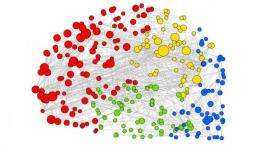Wiring the brain

(Medical Xpress) -- Researchers at the University of Cambridge have developed a simple mathematical model of the brain which provides a remarkably complete statistical account of the complex web of connections between various brain regions. Their findings have been published this week in the journal Proceedings of the National Academy of Sciences (PNAS).
The brain shares a similar pattern of connections with other complex networks such as social networks and the world wide web. However, until now, it was not known what rules were involved in the formation of the human brain network.
The scientists, from the Behavioral and Clinical Neuroscience Institute in the Department of Psychiatry, and the National Institute of Mental Health in the US, discovered that the network can be modeled as a result of just two different competing factors: a distance penalty based on the cost of maintaining long-range connections between various brain regions and a second term modeling the preference for links between regions sharing similar input.
Professor Ed Bullmore, lead author on the paper, explains the dynamic between the parameters they identified: “There is a huge amount of evidence that the wiring of brain networks tends to minimize connection costs. Less costly, short-distance connections are much more numerous than more costly, long-distance connections. So our model realistically includes a distance penalty on long-distance connections, which will tend to keep connection costs low.
“However, we found that cost control alone was not enough to reproduce a wide range of network properties. To do that, we had to model an economical trade-off between cost control and another term which favoured new, direct connections between regions that shared similar input or were otherwise already indirectly linked.”
The model not only increases our understanding of healthy brains, but the researchers believe it could also provide unique insight into disorders such as schizophrenia.
Dr. Petra Vertes, one of the authors of the paper, said: “Our model hints at possible mechanisms behind schizophrenia, which will be interesting to investigate further. We have been able to model the disease by tuning the parameters to allow a greater probability of connection between distant brain regions. This result echoes some prior neuroimaging results which suggest that brain networks in schizophrenia may be associated with an abnormal trade-off between connection costs and other topological properties of brain networks.”
















